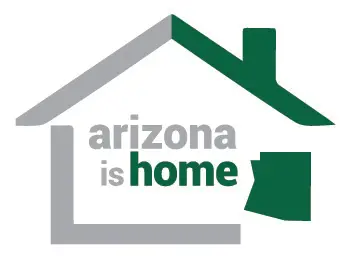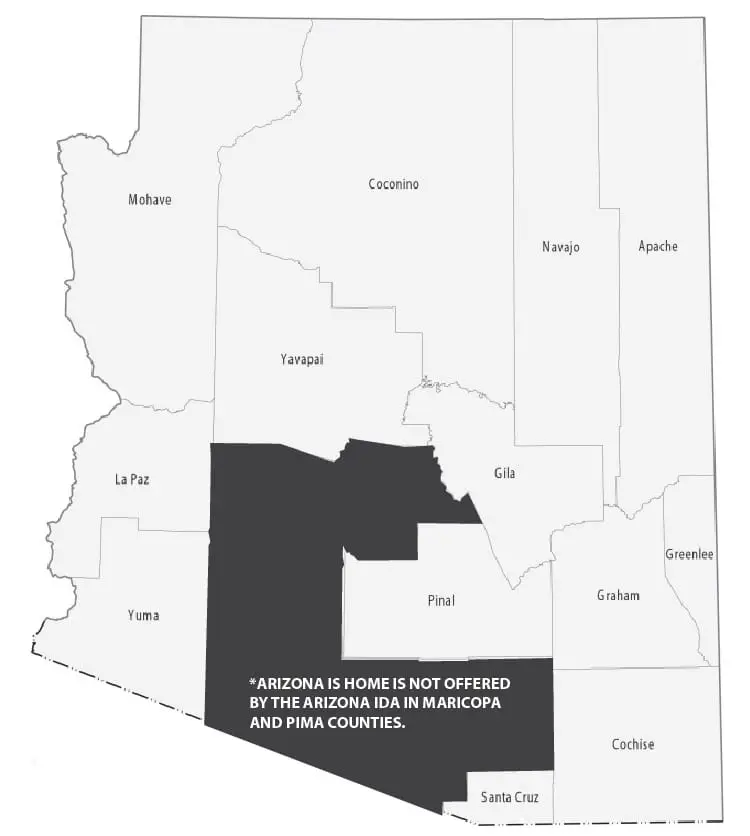
Let’s learn more about the Arizona IDA’s Arizona Is Home Program

Governor Hobbs’ Arizona is Home – Mortgage Assistance Program initiative is a collaboration between the Arizona Department of Housing (ADOH) and the Arizona Industrial Development Authority (Arizona IDA).
Eligible homebuyers will receive a below-market 30-year fixed-rate mortgage combined with 4% of down payment assistance. AIH Homebuyers must have annual incomes at or below 100% of the Area Median Income (AMI).
The Program is available in the following Arizona Counties: Apache, Cochise, Coconino, Gila, Graham, Greenlee, La Paz, Mohave, Navajo, Pinal, Santa Cruz, Yavapai, and Yuma. The Arizona IDA offers the Arizona Is Home Program in all Arizona Counties except for Pima and Maricopa.
Available in all of Arizona’s Rural Counties.
Receive a below-market 30-year fixed-rate mortgage combined with 4% of down payment assistance.
The borrower must complete a
home buyer education course before closing.
Eligible homebuyers must have annual incomes at or below 100% of the AMI-Area Median Income.
The second mortgage is fully forgiven after the 60th month.
WE’VE CREATED SOME VIDEOS TO HELP YOU BETTER UNDERSTAND THE HOME PLUS DPA PROGRAM. CONTINUE SCROLLING TO VIEW THEM.

Eligible borrowers receiving assistance through the Arizona Is Home Program, are receiving the benefit of a lower mortgage interest rate than is customarily available on other mortgage loans.
The Arizona Industrial Development Authority (Arizona IDA) has sold tax-exempt mortgage revenue bonds to a private investor who receives a lower interest rate on their investment than is customarily available on other investments. The investor buys the bonds because the interest earned is tax-exempt, which in turn creates the ability for us to offer a lower upfront interest rate for Arizona is Home homebuyers.
The down payment assistance (DPA) under the Arizona IDA’s Arizona Is Home program is provided in the form of a second mortgage with the following terms/conditions
The Arizona IDA’s ARIZONA IS HOME program consists of a five-year, no-interest, no payment, deferred soft second mortgage.
The Arizona IDA’s ARIZONA IS HOME DPA second mortgage is fully forgiven after the 60th month (5 years).
The Arizona IDA’s ARIZONA IS HOME DPA is based on 4% of the total first mortgage balance.
The homeowner can choose to refinance or sell their Arizona IDA’s ARIZONA IS HOME first mortgage at any time, however, if a refinance or sale occurs in the first 60 months, the DPA 2nd lien would need to be paid in full. The Arizona IDA does not subordinate or provide exceptions to the DPA repayment terms.
The interest rates for the respective underlying first mortgage are set by the Arizona IDA’s Arizona IDA and are the same for each program-approved participating lender. Closing costs can vary and are established by each approved participating lender.

When a borrower receives a first-time homebuyer loan with the Arizona IDA’s Arizona Is Home Program, they are receiving the benefit of a lower mortgage interest rate than is customarily available on other mortgage loans.
The Arizona Industrial Development Authority (Arizona IDA) has sold tax-exempt mortgage revenue bonds to a private investor who receives a lower interest rate on their investment than is customarily available on other investments.
The investor buys the bonds because the interest earned is tax-exempt. Because the investor does not pay tax on the interest earned on the bonds, the federal government considers this lost tax revenue. Tax-exempt means that the IRS (Internal Revenue Service) Code governs the program.
Congress enacted legislation in 1988, subsequently amended in October 1990, to recapture, under certain circumstances, some or the entire subsidy from homebuyers who receive qualified mortgage bond assistance after January 1, 1991 (the “Federal Recapture Tax”).
The law mandates a “recapture” of some of the benefit of the program if a Mortgagor meets all three (3) of the following criteria:
The most that you, the borrower, will ever be required to pay when you sell your home in the first 108 months is the lesser of 6.25% of the highest principal amount of the mortgage loan, including any second lien mortgage loan, during the life of the loan or one-half (1/2) of the gain on the sale of the home.
If Federal Recapture Tax is owed, it is computed and paid to the IRS for the tax year in which the Subject Property is sold.
The actual recapture tax, if any, can only be determined when the borrower sells their home.
Arizona Is Home borrowers will receive an About Recapture Tax disclosure and execute a Notice of Potential Recapture document at closing. The Notice of Potential Recapture document provides detail on the actual recapture tax calculations which incorporate holding period percentages, income percentages, and limitations.
Arizona IDA will reimburse any borrower who sells his or her home and is required to pay the federal recapture tax. The reimbursement from Arizona IDA will be limited to the actual amount of the recapture tax. Arizona IDA will not reimburse for any fees, interest, expenses or penalties incurred. Arizona IDA will not calculate the amount of the recapture tax owed by the borrower upon the sale or disposition of the home. Arizona IDA will pay for fees associated with the IRS Form 4506 that is required as part of the Request for Recapture Tax Reimbursement.
A borrower seeking to reimbursement for recapture tax will need to apply to Arizona IDA by July 15 of the calendar year immediately following the calendar year in which the home was sold. Arizona IDA will reimburse the borrower for payment of any recapture tax only if the Arizona IDA-financed first mortgage loan was outstanding at the time of sale (i.e., Arizona IDA will not reimburse the borrower if the Arizona IDA-financed first mortgage loan was refinanced before the sale of the home).
One of the borrowers must complete a pre-purchase homebuyer education course before the loan closing. It is recommended that the borrower completes this course as early as possible in the process, as it covers valuable information about buying and borrowing.
The homebuyer education requirement can be fulfilled by taking a pre-purchase homebuyer education course through a Home Plus approved online provider or in person with a HUD-certified homebuyer education provider.

The tabs below show the current mortgage loan products available and the maximum borrower income by county. *These are subject to change.
We understand that buying a home is a major life decision, and being well informed makes the process smoother. Please reach out to a local lending professional with any questions you may have. Our Find-A-Lender page shows over 150 lenders trained on the Home Plus program.
If at any point you feel your questions aren’t being answered properly or quickly, please contact another Home Plus approved lender. Find the relationship that feels most comfortable to you!
Eligible homebuyers must have annual incomes at or below 100%* of the AMI-Area Median Income*. The Program is available in the following Arizona Counties: Apache, Cochise, Coconino, Gila, Graham, Greenlee, La Paz, Mohave, Navajo, Pinal, Santa Cruz, Yavapai, and Yuma. The Arizona IDA offers the Arizona Is Home Program in all Arizona Counties except for Pima and Maricopa.
*The up-to-100% AMI limit is a temporary increase from the normal “up-to 80% AMI limit”. This increase became effective on October 1, 2024.

Temporary (AMI) Area Median Income limit increase to 100%. Beginning with new reservations on or after May 1, 2025. These limits apply only to Arizona Is Home. See Home Plus for that program’s County Limits.
The Arizona IDA does not offer the Arizona Is Home Program in Maricopa or Pima Counties. Please learn more about our Home Plus Program that is available in every county, city, and zip code in Arizona.
Sometimes called the “Product Matrix,” this list shows current mortgage types along with some details for each. It’s designed to help you quickly identify key information.
Scroll the table to the right to see more details.
| First Mortgage Type | Down Payment / Closing Cost Assistance | Minimum Credit Score | Lender SRP | Maximum Borrower(s) Income | Debt-to-Income Ratio | Maximum LTV/CLTV (*) |
|---|---|---|---|---|---|---|
| FHA | 4% | 620 | 1.50% | 100% AMI see income matrix for more detail | per AUS Findings | 96.50% |
| VA, USDA | 4% | 620 | 1.50% | 100% AMI see income matrix for more detail | per AUS Findings | 100% |
| HUD 184 – Tribal | 4% | 620 | 1.50% | 100% AMI see income matrix for more detail | per AUS Findings | 97.75% |
| FHA Manufactured Home | 4% | 620 | 1.50% | 100% AMI see income matrix for more detail | per AUS Findings | 96.50% |
| VA, USDA Manufactured Home | 4% | 620 | 1.50% | 100% AMI see income matrix for more detail | per AUS Findings | 100% |
| HUD 184 Tribal Manufactured Home | 4% | 620 | 1.50% | 100% AMI see income matrix for more detail | per AUS Findings | 97.75% |
| Fannie Mae HFA Preferred Manufactured Home | 4% | 620 | 1.50% | 100% AMI see income matrix for more detail | per AUS Findings | 95% / 105% |
| Fannie Mae HFA Preferred | 4% | 620 | 1.50% | 100% AMI see income matrix for more detail | per AUS Findings | 97% / 105% |
| Freddie Mac HFA Advantage | 4% | 620 | 1.50% | 100% AMI see income matrix for more detail | per AUS Findings | 97% / 105% |
There’s a lot to know before purchasing your new home! We want to help you get informed, be prepared, and have the knowledge you need before meeting with your lending professional.
Please take a few minutes to review the information below.
Nope, that’s not true. First of all, most programs define a first-time homebuyer as someone who hasn’t owned a home in the last three years.
If you have previously owned a home but are currently renting, you may still qualify as a first-time buyer. Additionally, not all programs specify that you must be a first-time homebuyer. Most housing agencies require that the home is occupied as a primary residence to qualify. Veterans are often eligible for a first-time homebuyer waiver as well.
To qualify for an assistance program, both the homebuyer and the property must meet specific criteria that differ depending on the program. Common requirements include the property’s location, type of home, sales price, household income, and homebuyer education certifications.
There are often additional benefits or completely separate programs for educators, protectors, healthcare workers, veterans, and households with disabled members.
Homebuyers must also demonstrate that they are financially responsible. Assistance programs have credit score thresholds and cash reserve requirements. Most programs will require a small amount of money down from the homebuyer, as well as homebuyer education, especially for first-time homebuyers, to ensure the long-term success of homeownership for each new buyer.
Contrary to what some might think, over 87% of all programs across the country have funds readily available for homebuyers. There are hundreds of millions of dollars in down payment assistance, grants, tax credits, and affordable first mortgages nationwide.
Each program operates on a different funding schedule. Some are funded by government sources such as municipal, quasi-government agencies, or non-profit groups. Others are privately financed, with some sponsored by employers. Every state has its own set of programs, and many local markets across the country also provide financial assistance. The three main types are down payment and closing cost aid, affordable first mortgages, and Mortgage Credit Certificates (MCCs).
Here’s the scoop—buying a home is probably the biggest purchase you’ll ever make, so it’s natural to want to do it right and make smart financial choices. When you apply for and use a down payment program, there’s some extra paperwork involved, but it’s similar to what you’re used to when applying for a home loan. Take some time to interview lenders who are knowledgeable about programs in your area and willing to work with you.
These lenders, known as “participating lenders,’ are qualified to handle these special programs and know how to seamlessly incorporate this financing into your home loan. That way, the process stays smooth and straightforward, without adding complications or delays. It’s a good idea to gather information about available programs before you start touring homes or get prequalified. Doing a little homework early on will make your home-buying journey much easier and more successful.
Don’t be misled by preconceived ideas about programs. Down payment programs aren’t only for specific buyers or very cheap homes in targeted neighborhoods. Homes in any neighborhood may qualify, with sales price limits from $200,000 to over $700,000 in high-cost areas.
A report with ATTOM Data/RealtyTrac showed 87 percent of homes qualify for at least one program. Some programs have income limits up to 120% of the area’s median income (AMI), sometimes higher, which can mean six-figure incomes.
Tiered assistance may vary by income; higher earners might receive less, but isn’t automatic disqualification. Income limits depend on household size; larger families have higher limits.
While FHA loans are often paired with down payment assistance, it doesn’t mean other loan options are unavailable. Today, you can find flexible down payment requirements with FHA and conventional financing. Many down payment assistance programs work with FHA, VA, USDA, and conventional loans.
How do you determine which is the best fit? It mainly depends on the purchase price and the assistance amount. For instance, if you have $5,000 in assistance on a $150,000 home, that’s just under FHA’s 3.5 percent down payment requirement, so you’d need to save a little more to meet the down payment. On the other hand, if you have $10,000 in assistance for the same $150,000 house, that covers more than 6 percent, potentially lowering your monthly payments, mortgage insurance, and loan fees. Keep in mind that many factors influence your options. Ask your lender about different loan choices to compare.
Every market across the country offers some form of down payment assistance. These programs vary widely, with some deferring payments or interest, while others provide grants or forgivable loans. It’s crucial to understand how these programs function. Almost all assistance programs place a lien on the property being financed, similar to the first mortgage. Homebuyer programs often take a subordinate second or even third lien position. However, not all programs require repayment.
Grants are usually given as gifts that don’t need to be paid back. The grant funds are given to you at closing. Grants that must be repaid often waive interest and allow deferred payments. This offers a unique upfront buying power and opportunity for homebuyers.
With deferred loans, payments are often delayed for the duration of the loan or grant, with 0% interest, and then the loan is forgiven after a certain number of years as long as you reside in the property.
Other programs might defer all payments and interest, or never charge or accrue interest, and use proceeds from a sale or refinance to “pay off” the lien.
Some programs require repayment of the loan when you sell the home. These programs still offer a chance to buy a home that might not have been affordable or possible otherwise. This is especially important in markets where rents are rising quickly.
It’s true that some of these programs may take a bit longer than a typical loan to underwrite, approve, reserve funds, and deliver closing documents. However, the closing timeline should be measured from the date the full down payment assistance application is submitted, not when the opportunity is first identified. That’s where the misconception lies.
So, do yourself a favor and research these programs early. By completing homebuyer education courses and other requirements upfront, you are getting a head start on your loan.
Bottom line: you’re trading a little extra effort to gain immediate equity and keep some of your savings. Housing agencies managing these programs should be seen as partners and experts. Ask your agent and lender to keep you updated throughout the process so you can meet your timeline expectations.
Are you worried that the seller will hesitate at a contract with financing beyond a typical first mortgage? While that might happen, we also know sellers want to sell their home for the best price. The real issue is the fear of longer or more complicated closings.
Sellers often hear that cash offers are better because they’re quick and cost less. But, is cash really superior? Keep in mind that buyers using down payment assistance are actually bringing extra funds to the table (and more bargaining power), enabling them to compete with other buyers on price and seller-paid costs. It also means the seller doesn’t need to accept a lower offer just to sell faster to a more aggressive (and less common) cash buyer. In fact, down payment assistance might cover items like closing costs and other seller-paid expenses, giving the seller even more advantage.
When agents and sellers are open to buyers using homebuyer programs, it can benefit everyone involved. To improve the timeline and ease seller concerns, you should complete homebuyer education early, submit loan documents to the lender quickly, and do your part to speed up the process from the start.
Every situation is different, but keep in mind that the average down payment for first-time homebuyers is only about 6 percent. The challenge of saving for a down payment is the number one reason most buyers wait longer than they’d like to buy a home. In fact, many sidelined buyers have the income and qualifications to make the monthly mortgage payment – they only lack the down payment.
Many consumers and experts still believe a 20 percent down payment is best. Yes, it helps you avoid paying private mortgage insurance (PMI), but it might be worth paying the PMI now and buying sooner. Consider this: when your rent goes up each year (not to mention those student loans), it becomes harder to save for that big down payment, keeping you stuck on the sidelines.
Renting until you have a 20 percent down payment can take years at a median income, all while prices and interest rates are rising. Down payment and closing cost assistance may help you finance some or all of your upfront costs, helping you get into a home sooner. Today’s down payment programs allow you to keep some of your savings for long-term homeownership success. Plus, during the application process and required homebuyer education, you learn about the responsibilities and expenses of homeownership, including appliance repair, yard upkeep, heating and air checkups, home budgeting, and more. With the help of down payment programs, you won’t have to spend every last penny on a down payment, avoiding being “house poor.” Instead, you can move in with a financial cushion, some skin in the game, and the necessary homebuyer education.
A down payment is just the amount of cash you contribute toward buying your home. For a $200,000 house, 20 percent down equals $40,000. No small sum.
Despite what you might have heard, a 20 percent down payment on a home isn’t always required. Here’s why.
The 20 Percent Down Myth: Then and Now
The myth that a 20 percent down payment is always required has persisted since the housing crisis over ten years ago. Access to credit became tighter, especially for median-income homebuyers. Even responsible buyers with sufficient income but without a large down payment faced similar obstacles. Fortunately, the situation has improved.
Low down payment options have existed for many years. In fact, data shows that low down payment loans with proper underwriting are just as successful as loans with larger down payments.
However, putting down 20 percent isn’t necessarily a bad thing. It may be the right choice for you if you have savings and investments in other assets. It gives you 20 percent equity in your home and helps you avoid paying a monthly fee for private mortgage insurance.
Sidelined Buyers Watch Housing Costs Rise
At the same time, saving 20 percent keeps many buyers on the sidelines. Additionally, high demand is quickly driving up home prices, making it harder to save for a down payment. The goalposts keep moving while you’re trying to do all the right things.
Buyers can strengthen their competitiveness in a competitive market in several ways. One method is to use a low-down-payment loan alongside down payment assistance. This strategy allows you to leverage and diversify your investments, so not all your money is confined to a single asset—your home.
What Are Your Options?
Wait and save. Just keep in mind that it’s estimated to take 14 years or more for a homebuyer to save for a 20 percent down payment. That’s more than 14 years for your rent, home prices, and interest rates to increase as well. And after 14 years, you’ll have zero equity in a home, erasing your and your next generation’s wealth-building potential.
Find a homeownership program. Most of these programs offer down payment and closing cost assistance, helping you cover some or all of your expenses. There are nearly 2,300 homeownership programs available nationwide, including grants, forgivable loans, below-market first mortgages, tax credits, and more.
The average benefit from down payment programs across all options exceeds $7,500. Both the home and the homebuyer need to qualify, so make sure to do your research early.
There Is No “One Size Fits All”
When it comes to home loans, there’s no ‘one size fits all” or single right choice for everyone. Just like you, your finances and home buying goals are unique. That’s why it’s important to secure your home financing before you tour that dream home.
Buying a home is one of the biggest financial decisions of your life. If you think you’re ready to buy a house, finding a real estate agent with the right experience to guide you through the process will be key.
There’s no shortage of agents vying for your business via online ads, yard signs, and even billboards. With so many professionals to choose from, finding the right one can be overwhelming. Follow these steps to learn how to choose a real estate agent, so that you hire the perfect pro for your purchase.
What does this have to do with finding the right agent? Well, home shoppers sometimes dive right into their search without talking to a mortgage lender. But it’s smart to meet with a lender first, before you even look for an agent, to learn how much you can afford to spend on a home.
Getting preapproved educates you on the maximum amount you are likely to be able to borrow early in the process. This helps you understand which homes are in the right price range for you, so you don’t waste time looking at listings beyond your means. In addition, it will show both agents and sellers that you’re a qualified buyer. In competitive markets, buyers might need a preapproval letter for sellers to even consider their offer.
There are a lot of real estate agents out there. One great way to find a good one is to ask people in your network if they can recommend someone with whom they’ve had a good experience.
Ideally, you want someone who has experience with clients in circumstances similar to yours. The needs of first-time homebuyers, for example, are different from those of repeat buyers or homeowners who are looking to downsize. And a downtown-condo specialist will have a different type of knowledge than an agent whose expertise lies in suburban single-family homes.
Some agents have certifications through the National Association of Realtors (NAR) to show that they’ve completed additional training in a certain area of expertise. Designations homebuyers might look for include:
When you’re considering candidates to see who you’d like to work with, start by examining their online presence: Check their website and social media accounts, noting whether they have closed deals in your specific area. The more familiar an agent is with the area you’re hoping to buy in, the better.
Take a look at their online reviews, as well. And you can vet candidates on your local Better Business Bureau’s website to see if they’ve received any complaints.
An interview is your opportunity to get a sense of an agent’s work style. Look for someone who not only knows your area but also understands your budget and needs.
“See how polished and professional their proposal is,” says Katherine Hutt, president and founder of Nautilus Communications and former chief communications officer with the Better Business Bureau. “The more effort they put into a presentation for you, the more effort they’ll put into presentations when they’re working for you. You want someone who is really savvy.”
Questions to ask include how long they’ve been an agent, whether they work full- or part-time and how many clients they currently have. It’s also a good idea to ask the typical price range and neighborhoods of homes they help their buyers find. If you’re a first-time buyer, inquire about their experience helping others who fall into this category. The same applies to other unique scenarios, like out-of-state relocations.
Interviews also give you a chance to find out the agent’s preferred method of communication and their availability. For example, if you’re most comfortable texting and expect to visit homes after work hours during the week, you’ll want an agent who’s happy to do the same.
Finally, ask the agents you’re interviewing to provide contact information for a few recent clients, so you can check their references. Reach out to those clients to find out their experiences and what type of support the agent provided throughout the process. Ask whether they’d hire that agent again for their next real estate transaction. If the agent was a referral from a friend or acquaintance, you already have a head start on this step.
This is an important one: Whether they represent the buyer or seller in a transaction, real estate agents earn a commission on the deal. Each agent’s commission typically falls somewhere between 2.5 and 3 percent of the home’s sale price; so, for a $350,000 home, that’s $8,750 to $10,500 for each.
But commission rates are negotiable, and the amount will vary depending on the deal. In addition, new rules have recently taken effect which mean that a home seller is no longer automatically expected to pay their buyer’s agent’s fee as well as their own — meaning you as the buyer might, or might not, be responsible for paying your agent out-of-pocket. Make sure you understand how much an agent will be paid before you agree to work with them, and when you go into contract on a home, be sure the contract clearly spells out who will be paying for which agent.
Above all, go with an agent you trust and will feel comfortable with if the road to closing gets a little bumpy. If you get a bad vibe from someone during your initial interview, that’s unlikely to change when you start working together.
“It’s like dating — sometimes it just comes down to chemistry,” says Herman Chan, an associate broker and Realtor with Golden Gate Sotheby’s International in Berkeley, California. “If everything checks out, but you just don’t vibe with that person, don’t go with them. There are plenty of other real estate agents out there that will be happy to help you and might be a better personality fit.”
Once you select an agent, you’ll need to sign a contract. The contract should spell out all the terms to which you’ve agreed, including the commission rate. Another factor to look at: the contract’s duration. Aim for a contract limited to a time frame of six months or less, if possible. According to NAR data, homes that sold in March 2025 typically remained on the market for just 36 days, so if you haven’t found the home you want within a few months, it’s helpful to keep your options open.
Bottom line
In a challenging housing market like today’s, where low inventory and high prices can restrict your buying options significantly, having a trusted agent by your side really makes a difference. Follow the steps above for how to choose a real estate agent who’s right for you and your specific situation.


Now that you’ve explored the Arizona Is Home program and understand how DPA from The Arizona IDA can benefit you, let’s move forward…
Discover our other program, Home Plus. Read frequently asked questions, learn about the program’s differences & similarities, or find an approved lender to take the next step in your journey to homeownership.
